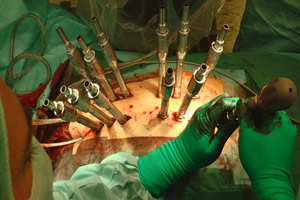VIDEO: Percutaneous stabilization of a T9/10 fracture in a patient with ankylosing spondylitis
In this video from Open Operating Theatre, Bastian Storzer, MD, from the Center for Spine and Scoliosis Therapy, Schön Klinik Nürnberg Fürth in Germany, spoke about percutaneous stabilization of a T9/10 fracture in a 69-year-old woman with ankylosing spondylitis.
The patient is placed in the prone position and fluoroscopy is used to make the pedicles visible. Jamshidi needles are then placed and K-wires are inserted into the vertebral body. The Jamshidi needles are then removed. Dilatators are inserted. Screws are inserted from T7 to L1, excluding T10 since it is fractured. All screws apart from T9 and T11 are augmented with polymethylmethacrylate under fluoroscopic control. After measuring, the length of the rods is determined. Screw loosening is seen at L1, so stabilization is extended to L2. The rods are then inserted in the cranial caudal direction and fixed to the screws. Then, the wound is closed.
This video is intended as a teaching tool to help surgeons prepare for surgery or they can use it as a refresher on the surgical technique and indications for this surgery.
Reference:

